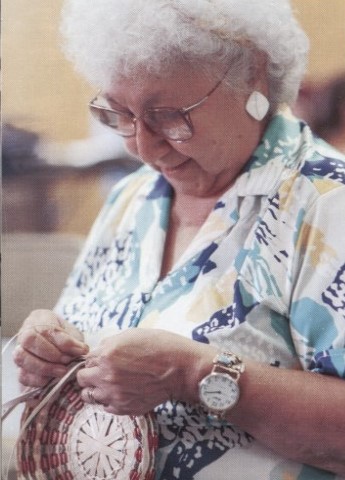Art Form: Anishinaabe black ash basket making
Location(s): Berrien Springs (Berrien County)
Agnes Rapp

Agnes Rapp making a basket; photo by Al Kamuda
Agnes Rapp (b. 1920), an enrolled member of the Grand Traverse Band of Ottawa and Chippewa Indians, learned to weave strips of black ash wood into basket designs from her Odawa stepparents, John and Dela McSawby. "They were into baskets all the time...so I grew up with basketry, you know...I mean I'd play making baskets although I didn't know how, but I'd pretend I knew how...I would cut up the material [black ash splints] on the floor and crisscross 'em and tie 'em up with string and stand 'em up and pretend I'd made a basket." (1) The family sold their baskets for food money during the Depression. By the time she was ten, Agnes was regularly helping Deliah make baskets and even filling orders on her own. "I got an order for myself to make little round baskets with the handles and when I got those finished the money was mine and I bought a pair of shoes."(2)
In 1939, Agnes married Michael Rapp, a Pokagon Potawatomi man from southern Michigan. They first lived in Leland and then, during World War II, moved to southwest Michigan because Michael got a job in a defense plant in Benton Harbor. They both joined a group of Potawatomis who regularly met at a community center in Dowagiac to make baskets. There Agnes has taught the traditional skill to the next generation of her family and conducted workshops (often with fellow awardee, her sister Julia Wesaw) for both Native and non-Native students. Within her immediate family, she has taught her daughter, Cindy Muffo, her daughter-in-law, Margaret Rapp, and Margaret's sister, Judy Augusta.
Her baskets are represented in many museum and private collections, including one in China. Agnes's black ash baskets are frequently experimental in style, incorporating new materials and shapes with traditional forms; several baskets resemble the flying saucer from Close Encounters of the Third Kind.
Agnes has appeared in numerous documentary videotapes, been the subject of many news articles and interviews, and was a featured artist in a 1984 exhibition at Western Michigan University. A 1987 participant in both the Smithsonian Institution's Festival of American Folklife and the first Festival of Michigan Folklife, Agnes often demonstrates her craft at art and nature centers, churches, schools, museums, and powwows.
(1) Rapp, Agnes. Audio recorded interview with Laura Quakenbush at the Great Lakes Indian Basket and Boxmakers Gathering, East Lansing, Michigan. August 1997.
(2) Rapp, Agnes. Audio recorded interview with Laura Quakenbush at the Great Lakes Indian Basket and Boxmakers Gathering, East Lansing, Michigan. August 1997.





